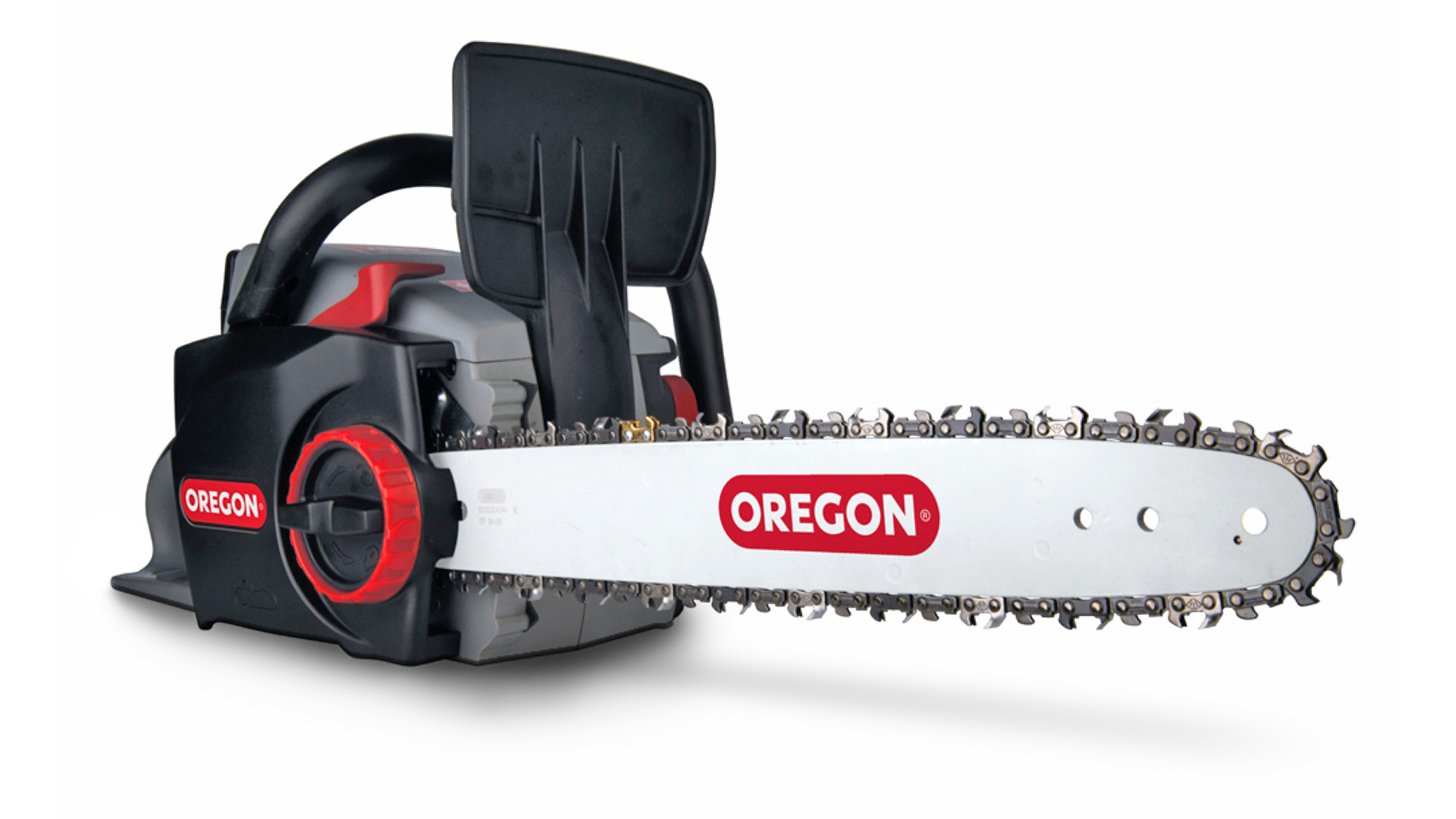Oregon CS300 vs Ryobi 18v ONE+ Cordless Pole Pruner: two cracking cordless chainsaws compared
Which chainsaw is best for your requirements – Oregon's powerhouse trunk slicer or Ryobi's mighty tall branch pruner?


So you want to find out which of these two heavy duty cutters, which are both in T3's best chainsaws buying guide, is right for you? Well you’ve come to the right place because today we’re taking a look at two different types of cordless chainsaw to help make your lopping life go with a swing – for want of a better word.
Chainsaws are powered in three different ways – electric cable, petrol engine and battery. Anyone with half a brain would advise steering well clear of electric chainsaws because there is no more incompatible a marriage than a fast-spinning chain blade and an electric cable. Which leaves petrol and battery as the best alternatives.
Petrol-powered chainsaws are obviously the preferred choice of professional tree surgeons because they work for hours at a time and require a quick source of regular fuel that batteries simply can’t provide. But petrol chainsaws are incredibly noisy and therefore scary. They’re heavy in the hand, too, and require some TLC to keep the engines in tip top condition. Which leaves the humble battery as the best fuel source for most domestic needs. Really, unless you have a large woodland that requires regular maintenance, a cordless chainsaw is well up to the task.
There’s a plethora of cordless chainsaws on the market but we’ve chosen two contrasting models to see how well they fair in their specific disciplines. Bring on the mighty Oregon CS300 and the tall-standing Ryobi 18v ONE+ Cordless 20cm Pole Pruner.
Oregon CS300 vs Ryobi 18v ONE+ Cordless Pole Pruner: design

The awesome Oregon CS300 in action
If you want serious cutting power for large branches and tree trunks up to 10 inches in diameter, the Oregon CS300 is one of the very best cordless models on the market. Oregon invented the type of chain used in most modern chainsaws so you can be sure the CS300’s whopping 40-inch chain bar will tackle the vast majority of garden lopping with consummate aplomb. Just be sure to pour some lubricating chain oil into the ample reservoir first.
The Oregon CS300 is available with our without a battery so if you already have some Oregon garden gear, chances are you’ll already have the correct battery to hand. If not, it will ship with Oregon’s 2.6Ah 36v battery which lasts for about 20 minutes. However there are other more powerful batteries in the range that will take its running time to in excess of an hour.
Aside from its efficiency at dealing with most major tasks, one of the best things about this model is that it has its own built-in chain sharpener. Simply run the motor, pull on the red handle for about two seconds and the chain is automatically sharpened.
Get all the latest news, reviews, deals and buying guides on gorgeous tech, home and active products from the T3 experts
At around 7kgs with battery fitted, the Oregon CS300 is no lightweight so perhaps avoid climbing ladders to lop off tall branches and instead consider using the Ryobi 18v ONE+ Cordless Pole Pruner which is designed for long-reach tasks.

Reach for the skies with the Ryobi 18v ONE+ Cordless Pole Pruner
The Ryobi is a marvellous tool for reaching high branches and hard-to-reach areas without having to use a ladder or ripping your arm to shreds on thorny ninjas. Its chain bar is only 20cm in length so it’s only good for branches up to about four inches in diameter. That said, four inches is a pretty substantial width – about the maximum diameter that most domestic users will ever need to deal with.
This chainsaw comes in three main parts – the chain bar and motor head with extension pole, the battery with the same length extension and a centre pole that can be used when high reach is required. At full length will all poles attached, this beast of a thing extends to four meters which is damn tall in my book. Stand say a metre up a ladder and you’ll be able reach branches at five metres in height – something that is simply not attainable unless you risk life and limb by scrambling up a really tall ladder.
This model is available mostly without a battery but since Ryobi’s ONE+ tool system is so popular, chances are many prospective users will already have the correct battery knocking about. The only real disappointment with this model is that the oil reservoir is really small so you will need to make regular top ups. Also, as is the norm with many chainsaws, a lot of woody detritus gets jammed around the rear of the chain so you may need to open the cover from time to time to give it a clear out.
Oregon CS300 vs Ryobi 18v ONE+ Cordless Pole Pruner: performance

I tested the Oregon CS300 on an apple tree and its 40cm (16-inch) chain bar scythed through a three-inch branch like it was made of blancmange. So I went for something bigger, the seven-inch trunk of an eight-year-old Ceanothus and it took no time at all to cut it clean in half. It’s an exemplary performer and the only chainsaw you'll ever need for most major tree surgery sessions.
By comparison, the Ryobi proved itself when it came to reaching tall tree branches. Granted, at full length the pole system bowed when held horizontally and it did feel unwieldy and pretty heavy on the arms – the included shoulder strap helped take some of the strain. Crucially, the 30° angled cutting head made it easier to perform cuts into the tops of branches while the top-heavy weight added cutting pressure so the saw did all the hard work. If you have a lot of tall trees in the garden, this strapping model will become your new horticultural go-to tool.
Oregon CS300 vs Ryobi 18v ONE+ Cordless Pole Pruner: verdict

There are smaller and cheaper cordless chainsaws than the Oregon CS300, but when it comes down to serious pollarding, this one covers all bases bar anything way above head height. That’s where the Ryobi steps in. My final thoughts? If you can afford the outlay, get both because that way you’ll be covered for all eventualities, whether it’s a thick 8-inch trunk or a 5-inch branch that’s way out of reach.
- Got a suburban lawn? You need a cordless lawn mower mate
- Got a country garden? Grab yourself petrol mower
Derek (aka Delbert, Delvis, Delphinium, Delboy etc) specialises in home and outdoor wares, from coffee machines, white appliances and vacs to drones, garden gear and BBQs. He has been writing for more years than anyone can remember, starting at the legendary Time Out magazine – the original, London version – on a typewriter! He now writes for T3 between playing drums with his bandmates in Red Box (redboxmusic).
